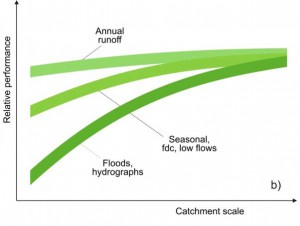The past IAHS decade on Runoff Prediction in Ungauged Basins (2003-2013)
by Florian Pappenberger, Walter Collischonn and Berit Arheimer from the IAHS conference in Gothenburg (this post is related to another post on the next IAHS decade)
The International Association of Hydrological Sciences (IAHS) launched the decade of Prediction in Ungauged Basins (PUB) in 2003. The aim of this initiative is in the title and it was officially closed/ended at the annual assembly of IAHS in Gothenburg (July 2013).  There have been many scientific achievements all documented in a recent book edited by Günter Blöschl et al. (Runoff Prediction in Ungauged Basins). However, we believe the greatest achievement was in bringing a community together working on an important topic and reporting on the state of the art in the prediction of ungauged catchments. The book contains chapters on, for example, data acquisition, prediction of annual runoff, seasonal runoff, flow duration curves, low flows, floods and, last but not least, on several case studies.
There have been many scientific achievements all documented in a recent book edited by Günter Blöschl et al. (Runoff Prediction in Ungauged Basins). However, we believe the greatest achievement was in bringing a community together working on an important topic and reporting on the state of the art in the prediction of ungauged catchments. The book contains chapters on, for example, data acquisition, prediction of annual runoff, seasonal runoff, flow duration curves, low flows, floods and, last but not least, on several case studies.
We could acknowledge many results in this blog post and the book is written in an excellent easy readable style – but if you are hard pressed for time, we recommend to read the beginning of the synthesis chapter (page 361 to 374, 14 pages) only. The true value of the book and results lie in the synthesis and comparative assessment of many studies (a total of 25000 catchments have been analysed).
 The synthesis chapter summarizes them with respect to hydrological runoff signatures (meaning, e.g., runoff from different temporal scales such as annual and seasonal runoff as well as low flows, floods and other hydrograph components). For example, the figure on the left displays the dependency of relative performance to catchment scale for different signatures. From a HEPEX perspective, it is interesting to note that in a forecasting framework the relationship is more complex as there are also interactions with the predictability of the meteorological forcings and the efficiency of the data assimilation or post-processing.
The synthesis chapter summarizes them with respect to hydrological runoff signatures (meaning, e.g., runoff from different temporal scales such as annual and seasonal runoff as well as low flows, floods and other hydrograph components). For example, the figure on the left displays the dependency of relative performance to catchment scale for different signatures. From a HEPEX perspective, it is interesting to note that in a forecasting framework the relationship is more complex as there are also interactions with the predictability of the meteorological forcings and the efficiency of the data assimilation or post-processing.
The PUB decade finishes with best practice recommendations for the modelling of ungauged catchments:
 Step 1: Read the landscape: meaning get to know your catchment and collect all information possible
Step 1: Read the landscape: meaning get to know your catchment and collect all information possible
Step 2: Runoff signatures and processes: analyse the runoff signatures of neighboring and similar catchments
Step 3: Process similarity and grouping: use step 1 and 2 to find similar neighboring catchments
Step 4: Model: build a model which is adequate for the purpose with all information available
Step 5: Hydrological interpretation establish hydrological interpretations for the model parameters
Step 6: Uncertainty: assess uncertainties
How does HEPEX benefit from PUB?
PUB was not focusing on forecasting and cannot be attributed to one single HEPEX theme, BUT (and this is a a VERY VERY BIG BUT) PUB touched the foundation of all of our themes. In particular, PUB is related to the key question: “How should the existing hydrological ensemble prediction systems be modified to account for all sources of uncertainty within a forecast?” From Walter’s experience working with sparsely gauged basins in Brazil the findings of PUB with relation to HEPEX are particular important in terms of the uncertainty associated to initial conditions of the forecasting model. While in well gauged basins the initial spread of the forecast can be considered to be relatively narrow, in ungauged basins the initial spread is possibly much wider.
A hydrological or land-surface model is at the heart of most of our forecasting systems and prediction in ungauged catchments (or catchments with very little information) is part of the daily routine of many HEPEX members.
Watch this space for a blog post of the future IAHS research program.
Acknowledgements: This post was only possible because Florian won the book at the PUB closure meeting, for which he is grateful.
0 comments